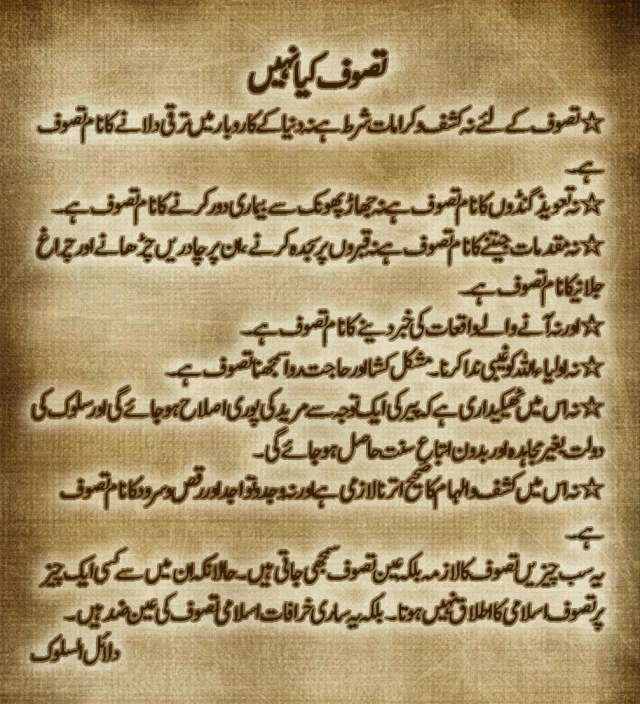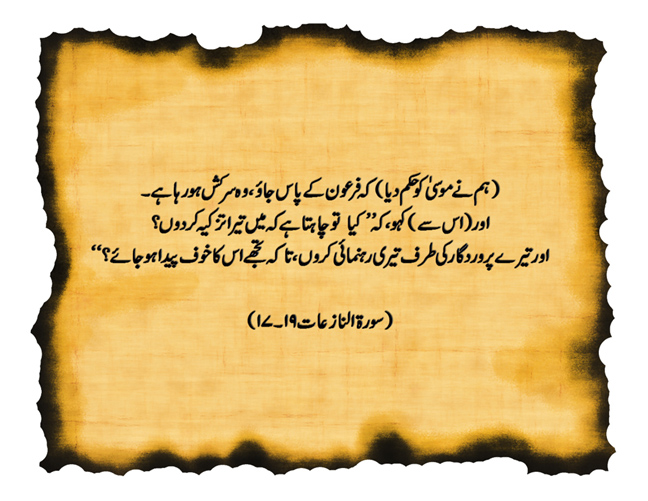
WHAT IS TASAWWUF

WHAT TASAWWUF IS NOT
Karamat or Kashf are not necessary in Sufism. Gaining success in the business of the world is not Tasawwuf. Tasawwuf is not the name of healing an illness by blowing on the patient. It is not a means to win feuds. It is not the name of touching one's forehead at a gravestone or lighting lamps or placing flowers at a grave. And nor does Sufism mean informing about future events. It is not the name of taking a Wali-Allah as easer of troubles or provider of needs and calling on to his name in his absence. In Sufism there is no concept of the teacher being a proxy for the seeker and it is not possible to achieve the invaluable wealth of Salook (Sufi Path) without striving for it and following the Sunnah. In true Sufism it is not a must that Kashf and paranormal visions will always be correct, and nor is it a name for tranced dancing on folk music. All these things are considered the essentials of Tasawwuf, whereas Islamic Sufism does not validate even a single one of such practices. Rather, all these absurdities are the exact opposites of Islamic Sufism.
TASAWWUF IS TO ISLAM AS MEANINGS ARE TO A WORD OR AS SPIRIT IS TO THE BODY [Hazrat Shah Waliullah]


جیسے باقی علوم فرض ہیں، اسی طرح علم سلوک بھی فرض ہے، جو علمِ احوالِ قلب ہے، جیسے توکل خشیت، رضا بالقضاء۔
صوفیہ کرام جس علم کو لدُنّی کہتے ہیں اس کا حصول فرض عین ہے۔
علامہ شامیؒ
DEFINITION, SCOPE AND HISTORY OF TASAWWUF
Definition of Tasawwuf
Sufism (Tasawwuf) is the knowledge through which the processes of spiritual purification, moral reformation, and inward and outward character building are identified, so that eternal success can be achieved, the soul can be reformed, and Allah's pleasure and nearness can be achieved. The scope of Sufism includes Tazkiyah (purification), Tasfiah (cleansing) and Inward character building. And the objective of Sufism is the achievement of everlasting success.
The History of Sufism
During the time of the Prophet ﷺ and his Companions, the terminology for different disciplines of the Deen like Tafseer, Fiqah, theological philosophy, Kalaam, Hadith had not yet been coined, although they existed in principle and spirit. These branches of Islamic knowledge were compiled under their present titles at a later stage. Similarly, the crucial component of Deen known as Tasawwuf today also existed in those times. Tazkiya or inner purification was a part of the Prophet'sﷺ mission and the lives of the Companions reflected this reality. Just like the other branches of knowledge, the compilation of Tasawwuf as a separate discipline took place in later times.
No other title was more exalted than the title of a Companion. Terms like Muhaddith, Mufassir, Faqeeh, or Sufi were not used for the Companions because they are the masters of all these disciplines. Later on, the people who devoted themselves to the knowledge of Tazkiya, Ihsan, or Tasawwuf became its torchbearers and specialists. Their lives were role models of piety, simplicity, and sincerity. They ate sparsely and simply and wore coarse garments made of Soof. They were known as Sufis and the branch of knowledge associated with them became known as Tasawwuf.
The Holy Quran refers to this part of the Deen as Taqwa (Piety), Tazkiya (Purification), Khashiat Allah (Fear of Allah) and the Hadith terms it as Ihsan. It has been regarded as the soul of Deen-e-Islam. Further details can be seen in the section Proof of Tasawwuf. In short, Tasawwuf, Sulook, Ihsan, and Ikhlas are the different names for the same reality.
The Two Aspects of Nabuwah (Prophethood)
There are two aspects of the Prophethood. Both are equally essential, as Allah says:
Allah has indeed done a great favor to the Muslims, that He sent a Prophet unto them who recites unto them His Verses, and purifies them, and teaches them of the Book and wisdom.(Aal-e-Imran 3-164)
The apparent or outward aspect of the Prophethood pertains to the recitation, instruction and explanation of the Quran. Whereas its inward or invisible aspect has to do with cleansing and purification of the inner self. Those respected people who benefited from the apparent or outward aspect of the Prophethood were termed as Mufassir, Muhaddith, Faqeeh and Muballigh. And those who were additionally blessed from the 'hidden' or inward aspect of the Prophethood were known as Sufi and some of them were appointed on the coveted ranks of Ghous, Qutab, Abdal and Qayyum. However, both branches stem from the Quran and the Sunnah.
حقیقی اسلامی تصوف و سلوک
آجکل کا مسلمان دین کے حوالے سے بہت سے شکوک و شبہات کا شکار ہے۔ دین کے احکام کو بظاہر تسلیم کرنے کے باوجود ان پر عمل پیرا ہونا انتہائی دشواردکھائی دیتا ہے۔ فرقہ بازیوں اور علمائے سُو کی فتنہ پردازیوں کی بدولت عقائد و ایمان بھی سلامت نہیں رہے، اعمال تو دور کی بات ہے۔ اس انتشار کی وجہ مسلمانوں کی ایک کثیر تعداد کا دین اسلام کے ایک انتہائی اہم رکن سے نا واقف ہونا ہے۔ یہ رکن تصوف و سلوک ہے۔
تصوف کو قران پاک اور حدیث مبارک میں تزکیہ اور احسان کے نام سے موسوم کیا گیا ہے۔ اس کا لفظی مطلب صفائی ہے، یعنی باطن یا نفس کی صفائی۔ دین پر کما حقہ عمل اسی وقت ممکن ہے جب تزکیہ نصیب ہو جائے۔ اسی بارے میں قران پاک کی اس آیت میں واضح حکم موجود ہے۔
قَدْ أَفْلَحَ مَنْ تَزَكَّى. وَذَكَرَ اسْمَ رَبِّهِ فَصَلَّى
فلاح پا گیا وہ شخص جس نے اپنا تزکیہ کیا۔ اور اپنے رب کے نام کا ذکر کرتا رہا، پھر نماز کا پابند ہو گیا
87:14،15
مندرجہ ذیل اقتباس حضرت مولانا اللہ یار خانؒ کی کتاب دلائل السلوک سے لئیے گئے ہیں۔ امید ہے کہ ان کے مطالعہ کے بعد تصوف کی تعریف و موضوع مزید واضح ہو جائیں گے۔
ِتصوف کیا ہے؟
لغت کے اعتبار سے تصوف کی اصل خواہ صوف ہو اور حقیقت کے اعتبار سے اس کا رشتہ چاہے صفا سے جاملے اس میں شک نہیں کہ یہ دین کا ایک اہم شعبہ ہے۔ جس کی اساس خلوص فی العمل اور خلوص فی النیت پر ہے اور جس کی غایت تعلق مع اللہ اور حصول رضائے الٰہی ہے۔ قرآن و حدیث کے مطالعہ نبی کریم ﷺ کے اسوہ حسنہ اور آثار صحابہؓ سے اس حقیقت کا ثبوت ملتا ہے۔
تصوف کیا نہیں
تصوف کے لئے نہ کشف و کرامات شرط ہے نہ دنیا کے کاروبار میں ترقی دلانے کا نام تصوف ہے نہ تعویذ گنڈوں کا نام تصوف ہے نہ جھاڑ پھونک سے بیماری دور کرنے کا نام تصوف ہے۔ نہ مقدمات جیتنے کا نام تصوف ہے نہ قبروں پر سجدہ کرنے، ان پر چادریں چڑھانے اور چراغ جلانیکا نام تصوف ہے۔ اور نہ آنے والے واقعات کی خبر دینے کا نام تصوف ہے۔ نہ اولیاء اللہ کو غیبی ندا کرنا۔ مشکل کشا اور حاجت روا سمجھنا تصوف ہے۔ نہ اس میں ٹھیکیداری ہے کہ پیر کی ایک توجہ سے مرید کی پوری اصلاح ہو جائے گی اور سلوک کی دولت بغیر مجاہدہ اور بدون اتباعِ سنت حاصل ہو جائے گی۔ نہ اس میں کشف و الہام کا صحیح اترنا لازمی ہے اور نہ وجد و تواجد اور رقص و سرود کا نام تصوف ہے یہ سب چیزیں تصوف کا لازمہ بلکہ عین تصوف سمجھی جاتی ہیں۔ حالانکہ ان میں سے کسی ایک چیز پر تصوف اسلامی کا اطلاق نہیں ہوتا۔ بلکہ یہ ساری خرافات اسلامی تصوف کی عین ضد ہیں۔
علمِ تصوف کی تعریف اور غایت
ھُوَ عِلْم’‘ تُعْرَفُ بِہٖ اَحْوَالُ تَزْکِیَۃِ النُّفُوْسِ وَ تَصْفِیَۃِ الاَخْلَاقِ وَ تَعْمِیْرِ الْبَاطِنِ وَالظَّاھِرِ لِنَیْلِ السَّعَادَۃِ الْاَبَدِیَّۃِ وَیَحْصِلُ بِہٖ اِصْلَاحُ النَّفْسِ وَالمَعْرِفَۃُ وَرَضَا ءُ الرَّبِّ وَمَوْضُوْعُہُ التَزْکِیَۃُ والتَّصْفِیَۃُ وَالتَّعْمِیْرُ الْمَذْکُوْرَاتِ وَغَایَتُہ’‘ نَیْل’ السَّعَادَۃِ الْاَبَدِیَّۃِ۔
"تصوف وہ علم ہے جس سے تزکیہ نفوس اور تصفیہ اخلاق اور ظاہر و باطن کی تعمیر کے احوال پہچانے جاتے ہیں۔ تاکہ سعادت ابدی حاصل ہو نفس کی اصلاح ہواور رب العالمین کی رضا اور اسکی معرفت حاصل ہواور تصوف کا موضوع تزکیہ تصفیہ اور تعمیر باطن ہے اور اس کا مقصد ابدی سعادت کا حصول ہے۔‘‘
تصوف کی تاریخ
عہدِ رسالت اور صحابہؓ کرام کے دور میں جس طرح دین کے دوسرے شعبوں تفسیر، اصول، فقہ، کلام وغیرہ کے نام اور اصطلاحات وضع نہ ہوئی تھیں ہر چند کہ ان کے اصول و کلیات موجود تھے اور ان عنوانات کے تحت یہ شعبے بعد میں مدون ہوئے اسی طرح دین کا یہ اہم شعبہ بھی موجود تھا۔ کیونکہ تزکیہ باطن خود پیغمبر ﷺ کے فرائض میں شامل تھا۔ صحابہؓ کی زندگی بھی اسی کا نمونہ تھی لیکن اس کی تدوین بھی دوسرے شعبوں کی طرح بعد میں ہوئی۔
صحابیت کے شرف اور لقب کی موجودگی میں کسی علیحدہ اصطلاح کی ضرورت نہیں تھی۔ یہی وجہ ہے کہ صحابہؓ کے لئے متکلم، مفسر، محدث، فقیہہ اور صوفی کے القاب استعمال نہیں کئے گئے۔ اس کے بعد جن لوگوں نے دین کے اس شعبہ کی خدمت کی اور اس کے حامل اور متخصص قرار پائے گئے۔ ان کی زندگیاں زہدو اتقاء اور خلوص و سادگی کا عمدہ نمونہ تھیں۔ ان کی غذا بھی سادہ اور لباس بھی موٹا جھوٹا اکثر صوف وغیرہ کا ہوتا تھا۔ اس وجہ سے وہ لوگوں میں صوفی کے لقب سے یاد کئے گئے اور اس نسبت سے ان سے متعلقہ شعبہ دین کو بعد میں تصوف کا نام دیا گیا۔ قرآن حکیم میں اسے تقویٰ ، تزکیہ اور خشیتہ اللہ سے تعبیر کیا گیا ہے اور حدیث شریف میں اسے ’’احسان‘‘ سے موسوم کیا گیا ہے اور اسے دین کا ماحصل قرار دیا گیا ہے۔ اس کی تفصیل حدیث جبریل ؑ میں موجود ہے۔ مختصر یہ کہ تصوف، احسان، سلوک اور اخلاص ایک ہی حقیقت کی مختلف تعبیریں ہیں۔
نبوّت کے دو پہلو
نبوت کے دو پہلو ہیں اور دونوں یکساں اہمیت رکھتے ہیں۔ کما قال تعالیٰ
لَقَدْ مَنَّ اللّٰہ عَلَی الْمُوء مِنِیْنَ اِذْ بَعَثَ فِیْھِمْ رَسُوْلًا مِّنْ اَنْفُسِھِمْ یَتْلُوا عَلَیْھِمْ اٰیَاتِہٖ وَیُزَکِّیْھِمْ وَیُعَلِّمُھُمُ الْکِتٰبَ وَالْحِکْمَۃَ (۱۶۴:۳)
حقیقت میں اللہ تعالیٰ نے مسلمانوں پر بڑا احسان کیا ہے جب کہ انہی میں سے ایک رسول ان میں بھیجا جو ان کو اس کی آئتیں پڑھ کر سناتا ہے اور انہیں پاک صاف کرتا ہے اور انہیں کتاب اور حکمت کی تعلیم دیتا ہے۔
نبوت کے ظاہری پہلو کا تعلق تلاوت آیات اور تعلیم و تشریح کتاب سے ہے اور اس کے باطنی پہلو کا تعلق تزکیہ باطن سے ہے۔ جن نفوس قدسیہ کو نبوت کے صرف ظاہری پہلو سے حصہ وافر ملا وہ مفسر،محدث فقیہہ اور مبلغ کے ناموں سے موسوم ہوئے اور جنہیں اس کے ساتھ ہی نبوت کے باطنی پہلو سے بھی سرفراز فرما یا گیا ان میں سے بعض غوثیت، قطبیت، ابدالیت اور قیومیت وغیرہ .کے مناصب پر فائز ہوئے مگر ان سب کا سرچشمہ کتاب و سنت ہے.
تصوف کا بنیادی اصول
اللہ اور بندے کے درمیان علاقہ قائم رکھنے والی چیز اعتصام بالکتاب والسنّہ ہے یہی مدار نجات ہے۔ قبر سے حشر تک اتباعِ کتاب و سنت کے متعلق ہی سوال ہوگا۔ یہی وجہ ہے محققین صوفیائے کرام نے شیخ یا پیر کے لئے کتاب و سنت کا عالم ہونا قراردیا ہے۔ اگر کوئی شخص ہوا میں اڑتا آئے مگر اسکی عملی زندگی کتاب و سنت کے خلاف ہے تو وہ ولی اللہ نہیں بلکہ جھوٹا ہے شعبدہ باز ہے کیونکہ تعلق مع اللہ کے لئے اتباعِ سنت لازمی ہے
کَمَا قَالَ تَعَا لیٰ
قُلْ اِنْ کُنْتُمْ تُحِبُّوْنَ اللّٰہ فَا تَّبِعُوْنِیْ یُحْبِبْکُمُ اللّٰہ۔ (۳:۳۱)
آپ فرمادیجئے کہ اگر تم اللہ تعالیٰ سے محبت رکھتے ہو تو تم لوگ میرا اتباع کرو۔ اللہ تعالیٰ تم سے محبت کرنے لگیں گے۔
اتباعِ سنت کا پورا پورا حق ان اللہ والوں نے ادا کیا جنہوں نے نبوت کے ظاہری اور باطنی دونوں پہلوؤں کی اہمیت کو محسوس کیا اور ہمیشہ پیش نظر رکھا اور تبلیغ و اشاعتِ دین کو تزکیہ نفوس سے کبھی جدا نہ ہونے دیا۔ تمام کمالات اور سارے مناصب صرف حضور اکرم ﷺ کی اتباع کی بدولت ہی حاصل ہوتے ہیں اور تصوف کا اصل سرمایہ اتباعِ سنت ہے۔






